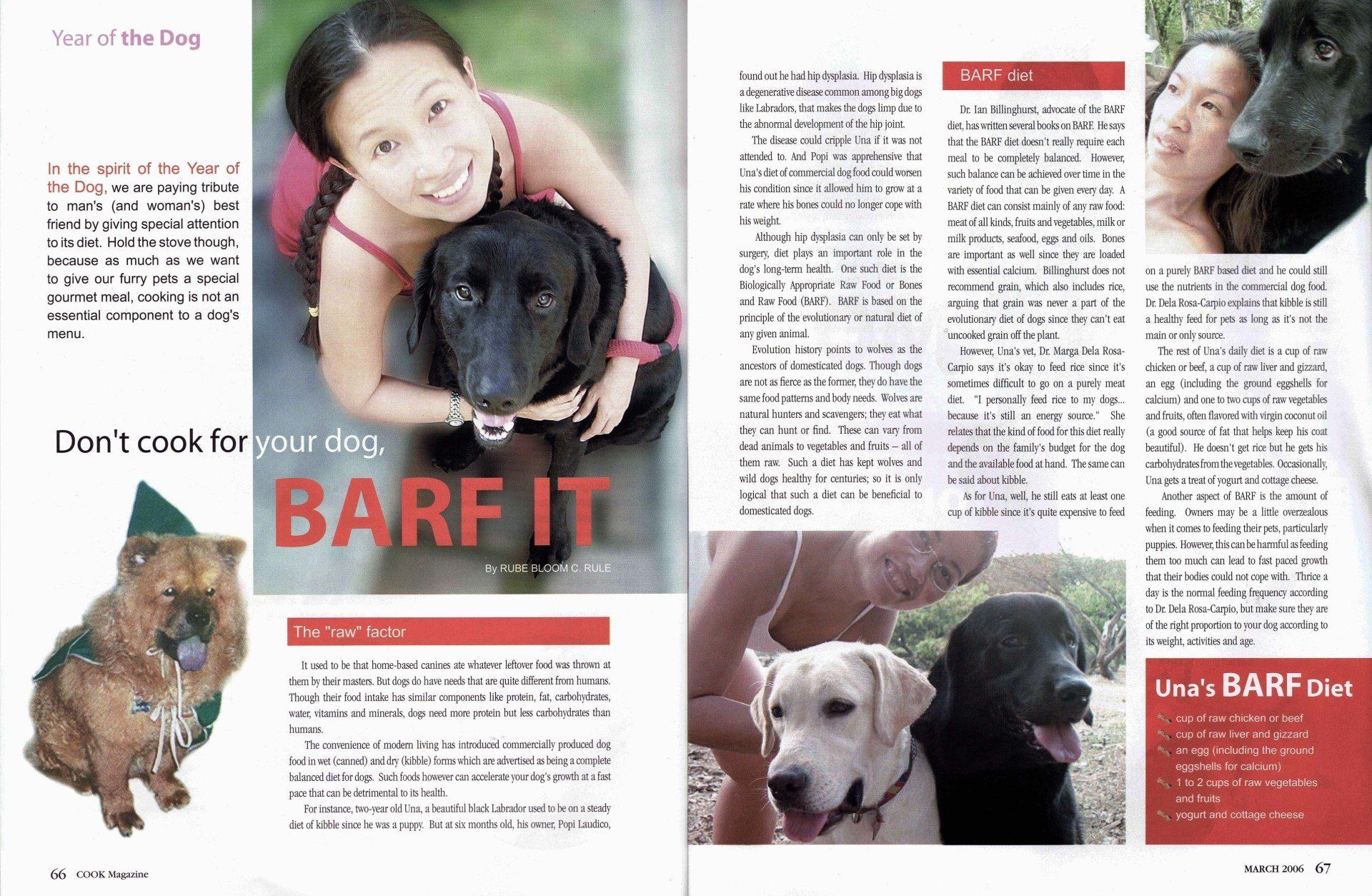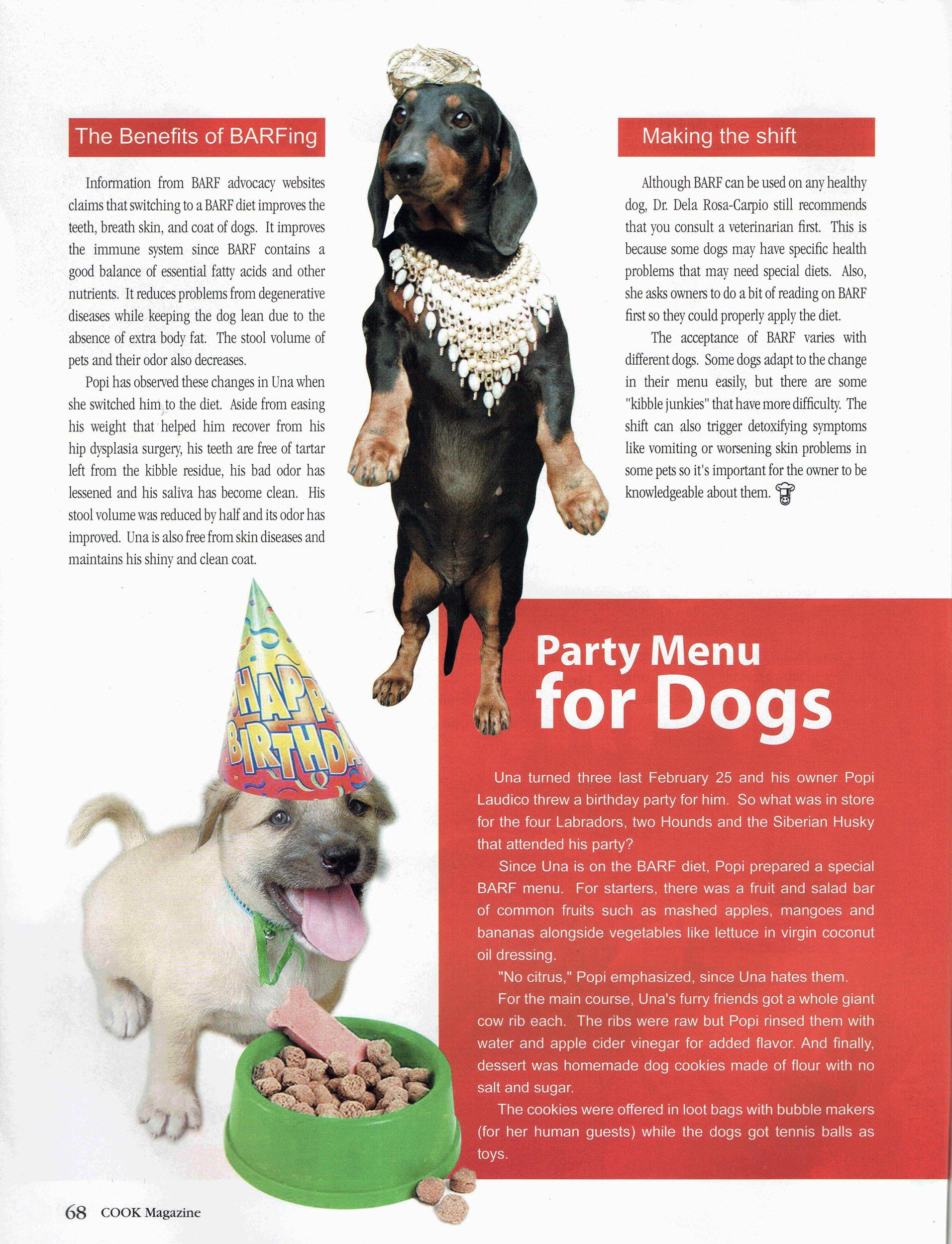Don’t cook for your dog, BARF IT
Cook Culinary Lifestyle Magazine
March 2006, pages 66-68
By Rube Bloom C. Rule
The “raw” factor
It used to be that home-based canines ate whatever leftover food was thrown at them by their masters. But dogs do have needs that are quite different from humans. Though their food intake has similar components like protein, fat, carbohydrates, water, vitamins and minerals, dogs need more protein but less carbohydrates than humans.
The convenience of modern living has introduced commercially produced dog food in wet (canned) and dry (kibble) forms which are advertised as being a complete balanced diet for dogs. Such foods however can accelerate your dog’s growth at a fast pace that can be detrimental to its health.
For instance, two-year old Una, a beautiful black Labrador used to be on a steady diet of kibble since he was a puppy. But at six months old, his owner, Popi Laudico, found out he had hip dysplasia. Hip dysplasia is a degenerative disease common among big dogs like Labradors, that makes the dogs limp due to the abnormal development of the hip joint.
The disease could cripple Una if it was not attended to. And Popi was apprehensive that Una’s diet of commercial dog food could worsen his condition since it allowed him to grow at a rate where his bones could no longer cope with his weight.
Although hip dysplasia can only be set by surgery, diet plays an important role in the dog’s long-term health. One such diet is the Biologically Appropriate Raw Food or Bones and Raw Food (BARF). BARF is based on the principle of the evolutionary or natural diet of any given animal.
Evolution history points to wolves as the ancestors of domesticated dogs. Though dogs are not as fierce as the former, they do have the same food patterns and body needs. Wolves are natural hunters and scavengers; they eat what they can hunt or find. These can vary from dead animals to vegetables and fruits – all of them raw. Such a diet has kept wolves and wild dogs healthy for centuries; so it is only logical that such a diet can be beneficial to domesticated dogs.
BARF diet
Dr. Ian Billinghurst, advocate of the BARF diet, has written several books on BARF. He says that the BARF diet doesn’t really require each meal to be completely balanced. However, such balance can be achieved over time in the variety of food that can be given every day. A BARF diet can consist mainly of any raw food: meat of all kinds, fruits and vegetables, milk or milk products, seafood, eggs and oils. Bones are important as well since they are loaded with essential calcium. Billinghurst does not recommend grain, which also includes rice, arguing that grain was never a part of the evolutionary diet of dogs since they can’t eat uncooked grain off the plant.
However, Una’s vet, Dr. Marga Dela Rosa-Carpio says it’s okay to feed rice since it’s sometimes difficult to go on a purely meat diet. “I personally feed rice to my dogs… because it’s still an energy source.” She relates that the kind of food for this diet really depends on the family’s budget for the dog and the available food at hand. The same can be said about kibble.
As for Una, well, he still eats at least one cup of kibble since it’s quite expensive to feed on a purely BARF based diet and he could still use the nutrients in the commercial dog food. Dr. Dela Rosa-Carpio explains that kibble is still a healthy feed for pets as long as it’s not the main or only source.
The rest of Una’s daily diet is a cup of raw chicken or beef, a cup of raw liver and gizzard, an egg (including the ground eggshells for calcium) and one to two cups of raw vegetables and fruits, often flavored with virgin coconut oil (a good source of fat that helps keep his coat beautiful). He doesn’t get rice but he gets his carbohydrates from the vegetables. Occasionally, Una gets a treat of yogurt and cottage cheese.
Another aspect of BARF is the amount of feeding. Owners may be a little overzealous when it comes to feeding their pets, particularly puppies. However, this can be harmful as feeding them too much can lead to fast paced growth that their bodies could not cope with. Thrice a day is the normal feeding frequency according to Dr. Dela Rosa-Carpio, but make sure they are of the right proportion to your dog according to its weight, activities and age.
The Benefits of BARFing
Information from BARF advocacy websites claims that switching to BARF diet improves the teeth, breath skin, and coat of dogs. It improves the immune system since BARF contains a good balance of essential fatty acids and other nutrients. It reduces problems from degenerative diseases while keeping the dog lean due to the absence of extra body fat. The stool volume of pets and their odor also decreases.
Popi has observed these changes in Una when she switched him to the diet. Aside from easing his weight that helped him recover from his hip dysplasia surgery, his teeth are free of tartar left from the kibble residue, his bad odor has lessened and his saliva has become clean. His stool volume was reduced by half and its odor has improved. Una is also free from skin diseases and maintains his shiny and clean coat.
Making the shift
Although BARF can be used on any healthy dog, Dr. Dela Rosa-Carpio still recommends that you consult a veterinarian first. This is because some dogs may have specific health problems that may need special diets. Also she asks owners to do a bit of reading on BARF first so they could properly apply the diet.
The acceptance of BARF varies with different dogs. some dogs adapt to the change in their menu easily, but there are some “kibble junkies” that have more difficulty. the shift can also trigger detoxifying symptoms like vomiting or worsening skin problems in some pets so it’s important for the owner to be knowledgeable about them.



